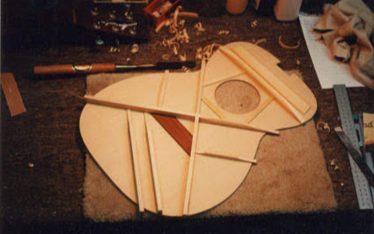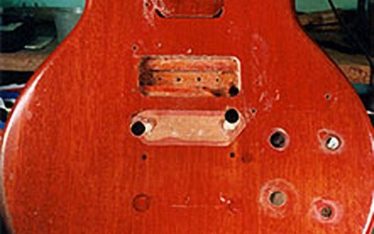Acoustic Guitar | Martin D-45, 1939

Repairing cracks on top of vintage Martin D-45, 1939.
The highest-value vintage guitar or most expensive guitar on the market is not always a masterpiece.
Unfortunately, there were a few cracks on the top because it was not carefully book-matched. If the wood grain is not straight at the center seam, then the great force caused by shrinking goes to one spot, so cracks start easily from that point. Even if the best materials are used in the building of a guitar, any small amount of carelessness will prevent it from being a masterpiece.
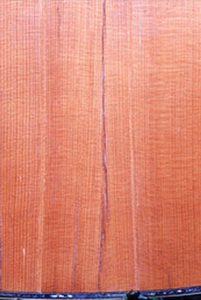 This guitar had a few cracks on the top, and half of those happened at the center seam. I planned to repair this group of cracks by installing a new section.
This guitar had a few cracks on the top, and half of those happened at the center seam. I planned to repair this group of cracks by installing a new section.
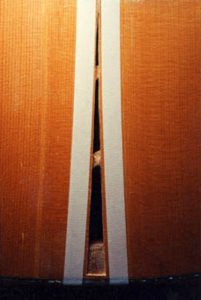 The new section’s outline follows the winter wood grain on both side of the center seam, which looks like a long wedge shape. The spruce for the new section must have the same curved grain. The piece of spruce should be book-matched exactly to the original. Do this by first spraying clear lacquer to check if it has the same feeling in its color, brightness and the depth of gloss, because a second round of repairs is not possible on this kind of repair.
The new section’s outline follows the winter wood grain on both side of the center seam, which looks like a long wedge shape. The spruce for the new section must have the same curved grain. The piece of spruce should be book-matched exactly to the original. Do this by first spraying clear lacquer to check if it has the same feeling in its color, brightness and the depth of gloss, because a second round of repairs is not possible on this kind of repair.
 The selected, book-matched spruce with finish on it should be shaped with a router using the template. After the new section is shaped, sand the back side of the new section to the proper thickness. When installing it, you can insert it from the end of the guitar and push it gently towards the sound hole. Because of its wedge shape, the new section will fit nicely into the top.
The selected, book-matched spruce with finish on it should be shaped with a router using the template. After the new section is shaped, sand the back side of the new section to the proper thickness. When installing it, you can insert it from the end of the guitar and push it gently towards the sound hole. Because of its wedge shape, the new section will fit nicely into the top.
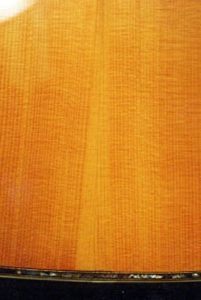 As the new section is finished with color and clear lacquer, the final lacquer coat will be very thin and minimal. Other cracks (except in the center seam) were repaired with transplanted parts from another old guitar top. Looking at photo #2, you can tell where the other cracks were.
As the new section is finished with color and clear lacquer, the final lacquer coat will be very thin and minimal. Other cracks (except in the center seam) were repaired with transplanted parts from another old guitar top. Looking at photo #2, you can tell where the other cracks were.
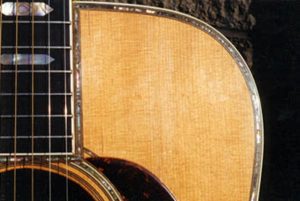
There were two cracks right here repaired with a transplanted piece from the old guitar top in the same era. The biggest merit of using the transplant technique is that both the wood and finish are vintage.
Can you tell where those cracks used to be?
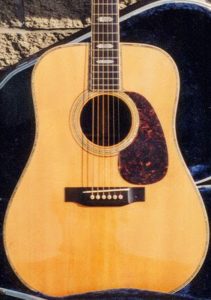
Where have all the cracks gone? Long time passing. I have fixed them, every one. When will they ever learn? When will they ever learn?







